The Updatechecker.exe is a nasty ‘ad-supported’ software (also known as adware). The adware is a part of malicious software that designed to show a huge number of unwanted pop up ads or mine crypto currencies without your permission. Complete the guide below as soon as possible. It’ll clear your PC system from the Updatechecker.exe adware thereby delete any unwanted ads and redirects from your web-browsers.
Technically, the Updatechecker.exe is not a virus, but it does bad things, it generates a ton of popup ads and mines digital moneny. It may download and install on to your computer other malicious and unwanted applications without your permission, force you to visit misleading or harmful web pages. Moreover, the ad-supported software can install browser hijacker. Once installed, it’ll modify your web-browser setting such as newtab, default search provider and start page with an undesired website.
The malicious applications from the adware family that changes the settings of browsers usually infects only the IE, Google Chrome, MS Edge and Firefox. However, possible situations, when any other web-browsers will be affected too. The Updatechecker.exe adware may modify the Target property of a browser’s shortcut file, so every time you open the web browser, instead of your home page, you’ll see an unknown web site.
We strongly advise that you perform the few simple steps below which will allow you to delete Updatechecker.exe adware using the standard features of Windows and some proven free applications.
Remove Updatechecker.exe adware (removal guidance)
Most commonly adware requires more than a simple uninstall through the use of Windows Control panel in order to be fully uninstalled. For that reason, our team created several removal solutions that we’ve summarized in a detailed guidance. Therefore, if you have the undesired Updatechecker.exe ad supported software on your PC system and are currently trying to have it uninstalled then feel free to follow the few simple steps below in order to resolve your problem. Some of the steps below will require you to shut down this website. So, please read the step-by-step instructions carefully, after that bookmark or print it for later reference.
To remove Updatechecker.exe, perform the steps below:
- How to remove Updatechecker.exe ‘ad supported’ software without any software
- Updatechecker.exe adware automatic removal
- Use AdBlocker to stay safe online
- How was Updatechecker.exe adware installed on personal computer
- Finish words
How to remove Updatechecker.exe ‘ad supported’ software without any software
Most common adware may be removed without any antivirus programs. The manual adware removal is steps that will teach you how to remove the Updatechecker.exe ad supported software.
Removing the Updatechecker.exe, check the list of installed apps first
First method for manual ‘ad supported’ software removal is to go into the Microsoft Windows “Control Panel”, then “Uninstall a program” console. Take a look at the list of apps on your machine and see if there are any dubious and unknown applications. If you see any, you need to delete them. Of course, before doing so, you can do an World Wide Web search to find details on the program. If it is a potentially unwanted program, adware or malicious software, you will likely find information that says so.
Make sure you have closed all web browsers and other applications. Press CTRL, ALT, DEL keys together to open the Microsoft Windows Task Manager.

Click on the “Processes” tab, look for something suspicious that is the Updatechecker.exe that causes web-browsers to show undesired pop ups then right-click it and select “End Task” or “End Process” option. In most cases, malware masks itself to avoid detection by imitating legitimate MS Windows processes. A process is particularly suspicious: it is taking up a lot of memory (despite the fact that you closed all of your programs), its name is not familiar to you (if you are in doubt, you can always check the program by doing a search for its name in Google, Yahoo or Bing).
Next, uninstall any undesired and suspicious apps from your Control panel.
Windows 10, 8.1, 8
Now, click the Windows button, type “Control panel” in search and press Enter. Choose “Programs and Features”, then “Uninstall a program”.
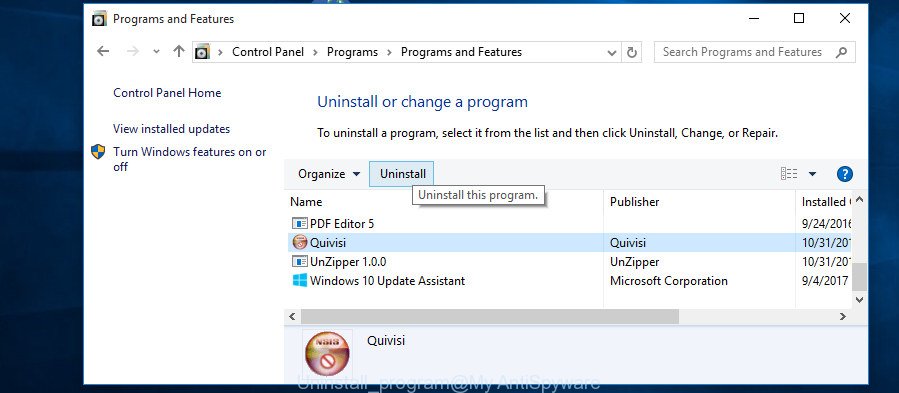
Look around the entire list of programs installed on your PC system. Most likely, one of them is the Updatechecker.exe adware that causes web browsers to display undesired pop up advertisements. Choose the questionable program or the application that name is not familiar to you and uninstall it.
Windows Vista, 7
From the “Start” menu in Microsoft Windows, select “Control Panel”. Under the “Programs” icon, choose “Uninstall a program”.
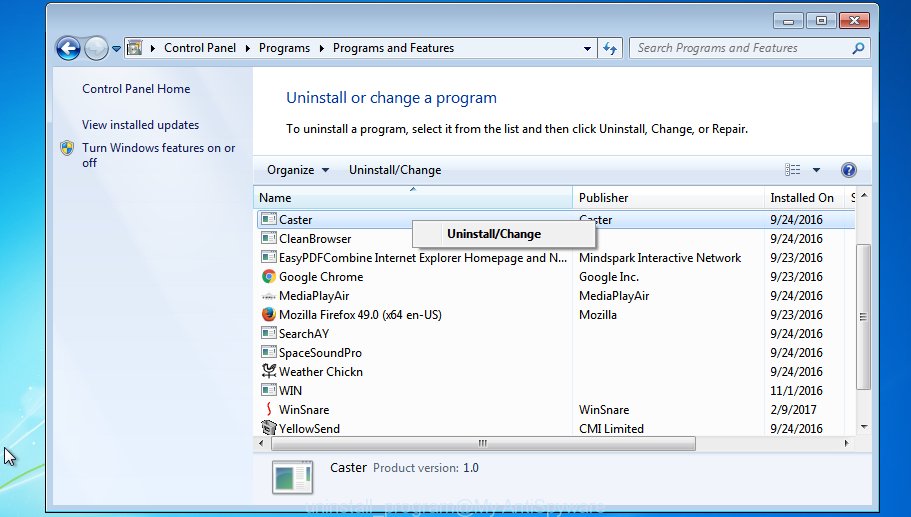
Choose the suspicious or any unknown programs, then press “Uninstall/Change” button to delete this undesired application from your PC system.
Windows XP
Click the “Start” button, select “Control Panel” option. Click on “Add/Remove Programs”.
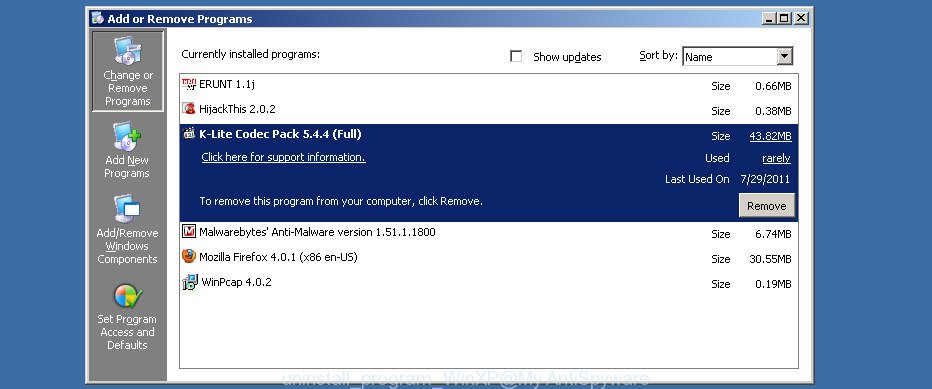
Choose an undesired application, then click “Change/Remove” button. Follow the prompts.
Remove unwanted Scheduled Tasks
If an annoying web site opens automatically on Windows startup or at equal time intervals, then you need to check the Task Scheduler Library and remove all tasks which have been created by the Updatechecker.exe.
Press Windows and R keys on the keyboard simultaneously. This shows a prompt that titled with Run. In the text field, type “taskschd.msc” (without the quotes) and click OK. Task Scheduler window opens. In the left-hand side, press “Task Scheduler Library”, as shown on the screen below.
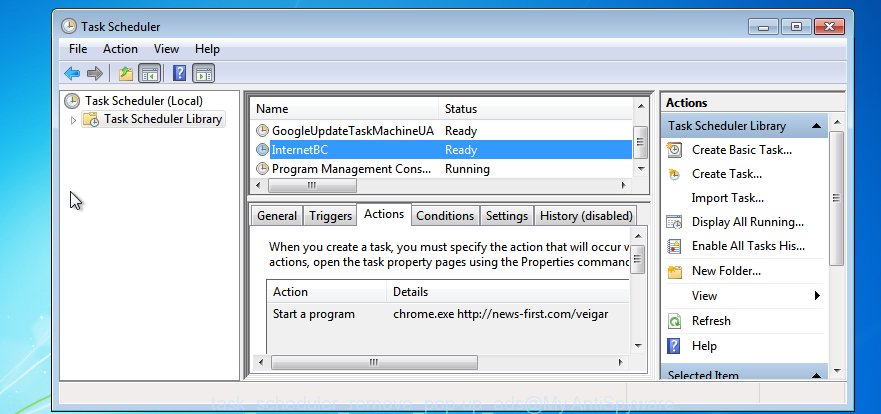
Task scheduler
In the middle part you will see a list of installed tasks. Please select the first task, its properties will be open just below automatically. Next, click the Actions tab. Pay attention to that it launches on your PC. If you are not sure that executes the task, check it through a search engine. If it’s a component of the ‘ad-supported’ program, then this task also should be removed.
Having defined the task that you want to remove, then click on it with the right mouse button and select Delete as displayed in the following example.

Delete a task
Repeat this step, if you have found a few tasks that have been created by the Updatechecker.exe adware. Once is finished, close the Task Scheduler window.
Disinfect the internet browser’s shortcuts
Important to know, most anti-malware programs which are able to delete Updatechecker.exe adware that cause intrusive popup ads to appear, but unable to scan for and recover changed shortcuts. So, you need to fix the desktop shortcuts for your Internet Explorer, MS Edge, Firefox and Google Chrome internet browsers manually.
Right click to a desktop shortcut file for your hijacked web browser. Choose the “Properties” option. It’ll show the Properties window. Select the “Shortcut” tab here, after that, look at the “Target” field. The Updatechecker.exe adware can modify it. If you are seeing something such as “…exe http://site.address” then you need to remove “http…” and leave only, depending on the browser you are using:
- Google Chrome: chrome.exe
- Opera: opera.exe
- Firefox: firefox.exe
- Internet Explorer: iexplore.exe
Look at the example as shown below.
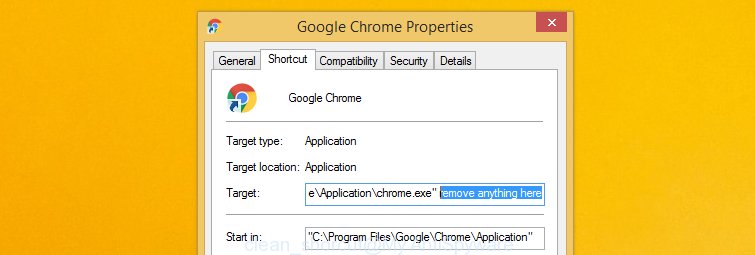
Once is finished, click the “OK” button to save the changes. Please repeat this step for web-browser shortcut files which redirects to annoying websites. When you’ve completed, go to next step.
Updatechecker.exe adware automatic removal
In order to completely get rid of Updatechecker.exe, you not only need to delete ad supported software from your PC, but also get rid of all its components in your computer including Windows registry entries. We suggest to download and use free removal tools to automatically free your computer of Updatechecker.exe adware.
Run Zemana Anti-malware to remove Updatechecker.exe
You can remove Updatechecker.exe automatically with a help of Zemana Anti-malware. We suggest this malware removal utility because it can easily get rid of browser hijackers, potentially unwanted apps, adware that redirects your web-browser to Updatechecker.exe website with all their components such as folders, files and registry entries.
Visit the page linked below to download the latest version of Zemana Anti-Malware (ZAM) for MS Windows. Save it directly to your Microsoft Windows Desktop.
165497 downloads
Author: Zemana Ltd
Category: Security tools
Update: July 16, 2019
Once the downloading process is finished, close all windows on your personal computer. Further, run the set up file named Zemana.AntiMalware.Setup. If the “User Account Control” dialog box pops up as on the image below, press the “Yes” button.
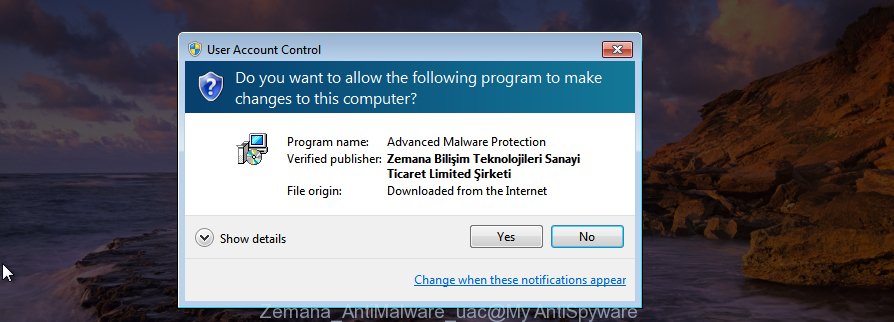
It will display the “Setup wizard” which will assist you install Zemana Free on the personal computer. Follow the prompts and do not make any changes to default settings.

Once setup is complete successfully, Zemana Free will automatically run and you can see its main window like below.

Next, click the “Scan” button to detect Updatechecker.exe adware and other malicious software. This procedure can take quite a while, so please be patient. During the scan Zemana Free will search for threats exist on your PC system.

Once Zemana has finished scanning your system, the results are displayed in the scan report. Once you have selected what you want to remove from your computer press “Next” button.

The Zemana will uninstall Updatechecker.exe. When the cleaning process is finished, you can be prompted to reboot your personal computer.
Scan your personal computer and remove Updatechecker.exe ad supported software with Hitman Pro
All-in-all, HitmanPro is a fantastic tool to free your computer from any undesired programs like Updatechecker.exe. The Hitman Pro is portable application that meaning, you do not need to install it to use it. HitmanPro is compatible with all versions of Windows operating system from MS Windows XP to Windows 10. Both 64-bit and 32-bit systems are supported.
HitmanPro can be downloaded from the following link. Save it on your Windows desktop or in any other place.
After the downloading process is finished, open the file location. You will see an icon like below.

Double click the Hitman Pro desktop icon. After the tool is opened, you will see a screen as shown on the image below.

Further, click “Next” button . HitmanPro tool will begin scanning the whole computer to find out Updatechecker.exe ‘ad supported’ software which redirects your web browser to intrusive ad web-sites. Depending on your computer, the scan can take anywhere from a few minutes to close to an hour. When the system scan is done, you will be shown the list of all detected items on your PC system like below.
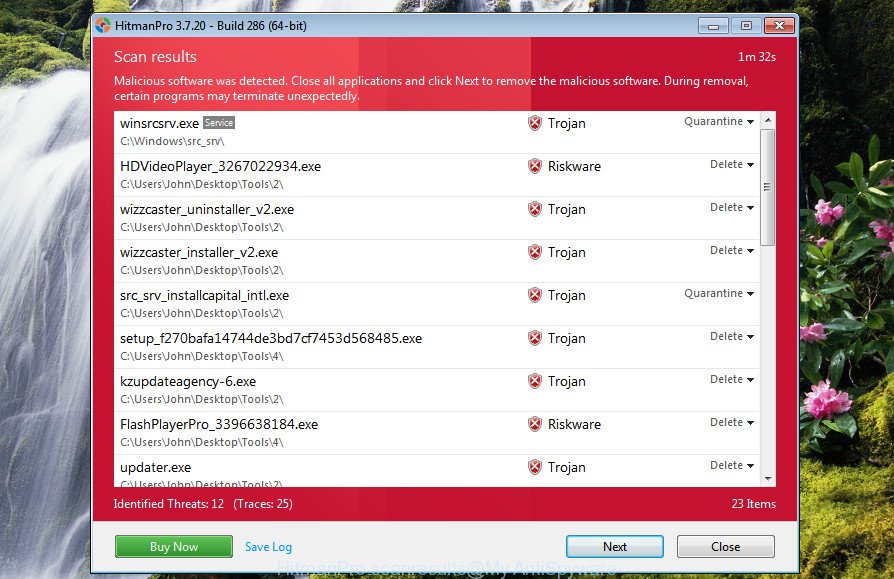
Review the scan results and then press “Next” button. It will open a prompt, click the “Activate free license” button.
Remove Updatechecker.exe with Malwarebytes
Get rid of Updatechecker.exe ‘ad supported’ software manually is difficult and often the adware is not completely removed. Therefore, we recommend you to use the Malwarebytes Free which are completely clean your system. Moreover, the free application will help you to remove malicious software, potentially unwanted software, toolbars and hijackers that your PC system can be infected too.
Installing the MalwareBytes AntiMalware (MBAM) is simple. First you will need to download MalwareBytes by clicking on the link below.
327716 downloads
Author: Malwarebytes
Category: Security tools
Update: April 15, 2020
When the downloading process is complete, close all windows on your machine. Further, run the file called mb3-setup. If the “User Account Control” dialog box pops up as shown in the following example, press the “Yes” button.

It will show the “Setup wizard” that will help you install MalwareBytes on the machine. Follow the prompts and don’t make any changes to default settings.
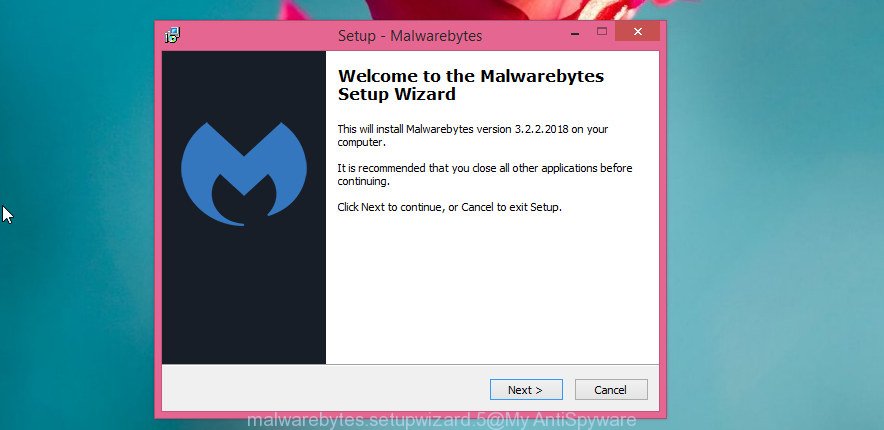
Once installation is finished successfully, click Finish button. Then MalwareBytes Anti-Malware (MBAM) will automatically launch and you can see its main window like below.
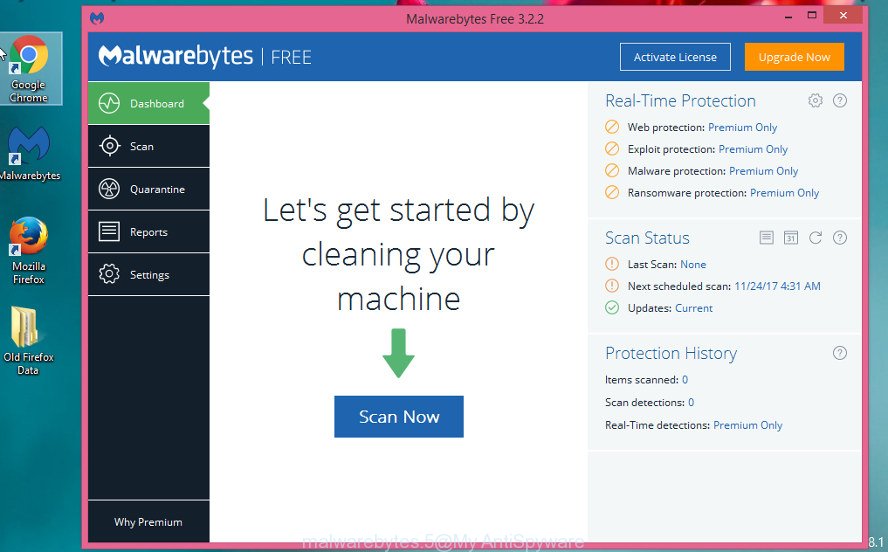
Next, press the “Scan Now” button for checking your system for the Updatechecker.exe ad supported software. A scan can take anywhere from 10 to 30 minutes, depending on the number of files on your PC and the speed of your machine. When a threat is detected, the number of the security threats will change accordingly.
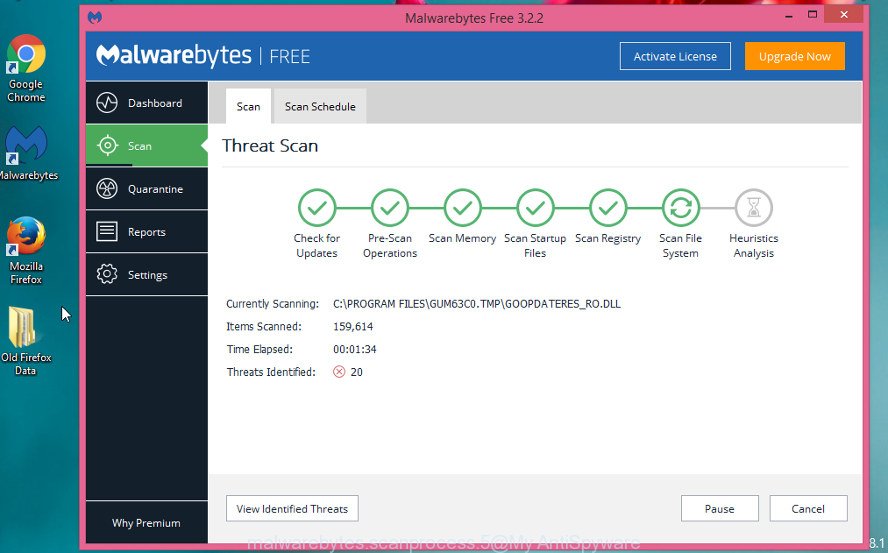
After that process is complete, a list of all threats found is prepared. Review the results once the tool has finished the system scan. If you think an entry should not be quarantined, then uncheck it. Otherwise, simply click “Quarantine Selected” button.
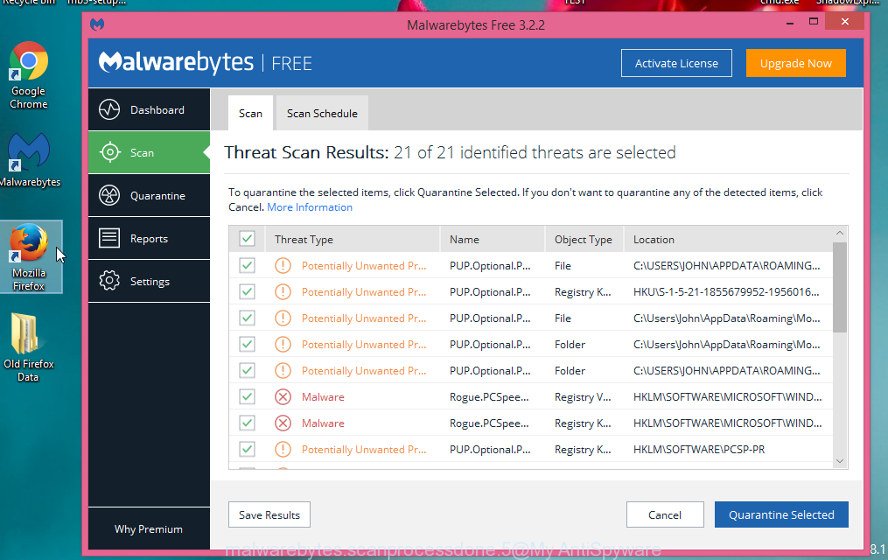
The MalwareBytes Free will begin to remove Updatechecker.exe ad supported software that made to redirect your internet browser to various ad webpages. Once the cleaning procedure is finished, you can be prompted to restart your PC system. We recommend you look at the following video, which completely explains the procedure of using the MalwareBytes to remove hijacker infections, adware and other malware.
Use AdBlocker to stay safe online
Enabling an ad blocker program like AdGuard is an effective way to alleviate the risks. Additionally, ad-blocker applications will also protect you from malicious ads and web-sites, and, of course, stop redirection chain to misleading, harmful and similar websites.
Visit the page linked below to download AdGuard. Save it to your Desktop so that you can access the file easily.
27034 downloads
Version: 6.4
Author: © Adguard
Category: Security tools
Update: November 15, 2018
After downloading it, run the downloaded file. You will see the “Setup Wizard” screen as shown on the image below.

Follow the prompts. Once the installation is finished, you will see a window as shown below.

You can press “Skip” to close the install application and use the default settings, or click “Get Started” button to see an quick tutorial which will assist you get to know AdGuard better.
In most cases, the default settings are enough and you don’t need to change anything. Each time, when you start your PC, AdGuard will launch automatically and stop pop-up ads, as well as other malicious or misleading web-pages. For an overview of all the features of the program, or to change its settings you can simply double-click on the AdGuard icon, which may be found on your desktop.
How was Updatechecker.exe adware installed on personal computer
Most of unwanted software such as the Updatechecker.exe adware come with web-browser toolbars, internet browser extensions, BHOs (browser helper objects) and optional software. Most often, these items claim itself as programs which improve your experience on the Web by providing a fast and interactive homepage or a search engine that does not track you. Remember, how to avoid the unwanted software. Be cautious, run only reputable apps which download from reputable sources. NEVER install any unknown and suspicious applications.
Finish words
Now your computer should be clean of the Updatechecker.exe adware. We suggest that you keep AdGuard (to help you stop unwanted advertisements and undesired harmful pages) and Zemana AntiMalware (to periodically scan your machine for new adwares and other malware). Probably you are running an older version of Java or Adobe Flash Player. This can be a security risk, so download and install the latest version right now.
If you are still having problems while trying to delete Updatechecker.exe adware from the Windows 10 (8, 7, XP), then ask for help in our Spyware/Malware removal forum.


















